Abstract
Growth hormone (GH)-releasing activity has been detected in extracts of carcinoid and pancreatic islet tumors from three patients with GH-secreting pituitary tumors and acromegaly. Bioactivity was demonstrated in 2 N acetic acid extracts of the tumors using dispersed rat adenohypophyseal cells in primary monolayer culture and a rat anterior pituitary perifusion system. The GH-releasing effect was dose responsive and the greatest activity was present in the pancreatic islet tumor. Small amounts of activity were also found in two other tumors (carcinoid and small cell carcinoma of lung) unassociated with GH hypersecretion. Each of the tumors contained somatostatin-like immunoreactivity but the levels did not correlate with the net biologic expression of the tumor. Sephadex G-75 gel filtration indicated the GH-releasing activity to have an apparent molecular size of slightly greater than 6,000 daltons. The GH-releasing activity was adsorbed onto DEAE-cellulose at neutral pH and low ionic strength, from which it could be eluted by increasing ionic strength. The GH-releasing activity was further purified by high pressure liquid chromatography using an acetonitrile gradient on a cyanopropyl column to yield a preparation that was active at 40 ng protein/ml. Partially purified GH-releasing activity, from which most of the bioactive somatostatin had been removed, increased GH release by pituitary monolayer cultures to five times base line. Enzymatic hydrolysis studies revealed that the GH-releasing activity was resistant to carboxypeptidase, leucine-aminopeptidase, and pyroglutamate-amino-peptidase but was destroyed by trypsin and chymotrypsin, indicating that internal lysine and/or arginine and aromatic amino acid residues are required for biologic activity and that the NH2-terminus and CO9H-terminus are either blocked or not essential. The results provide an explanation for the presence of GH-secreting tumors in some patients with the multiple endocrine neoplasia syndrome, type I, and warrant the addition of GH-releasing activity to the growing list of hormones secreted by tumors of amine precursor uptake and decarboxylation cell types.
Full text
PDF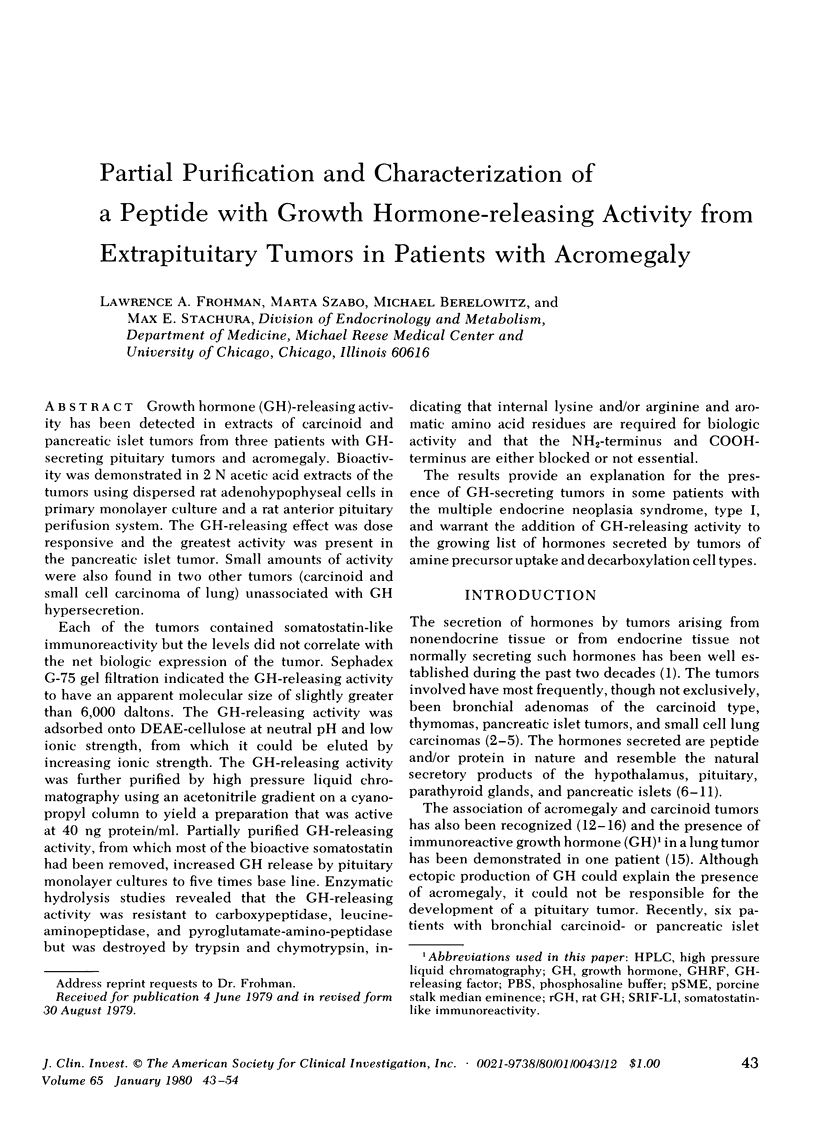
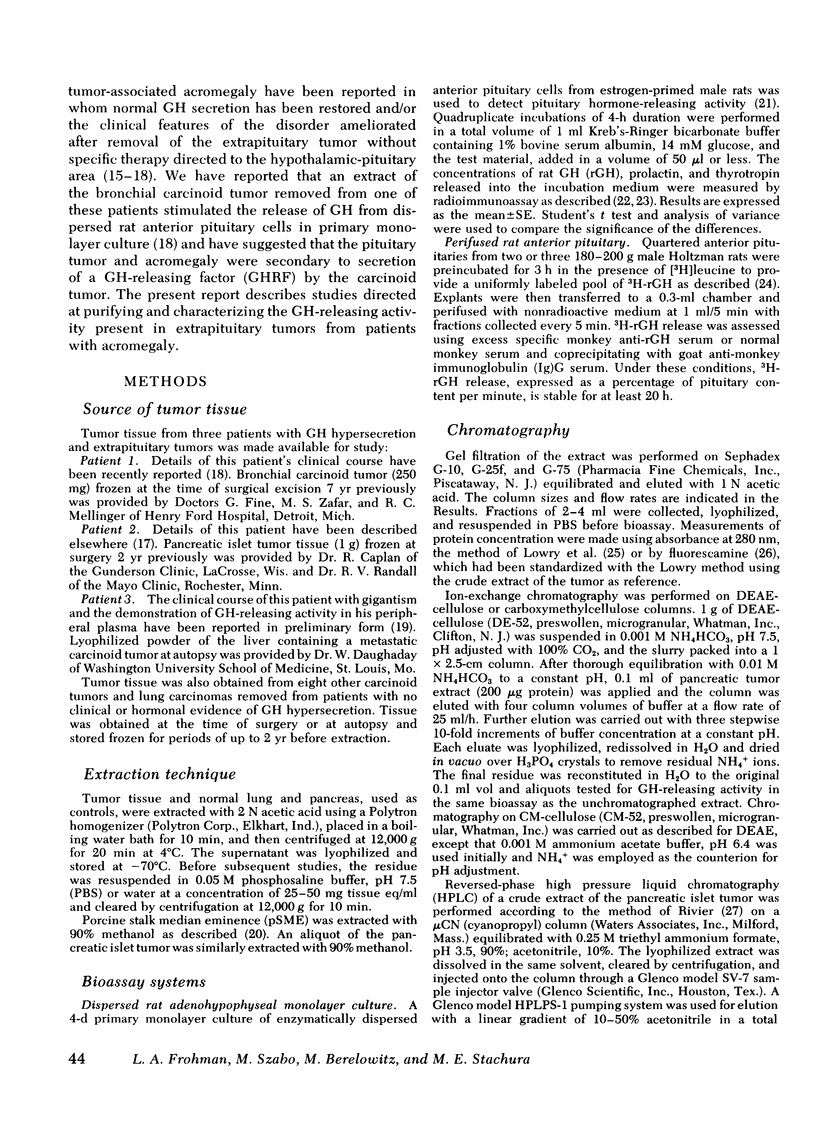
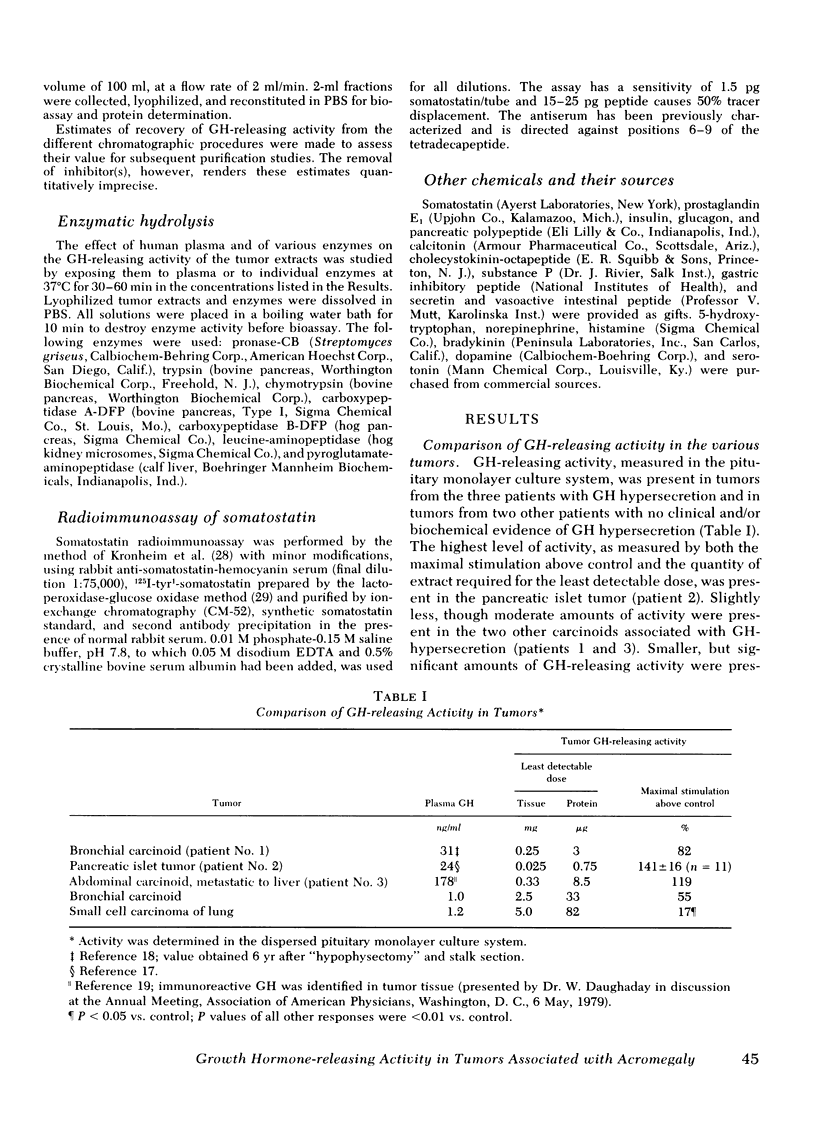
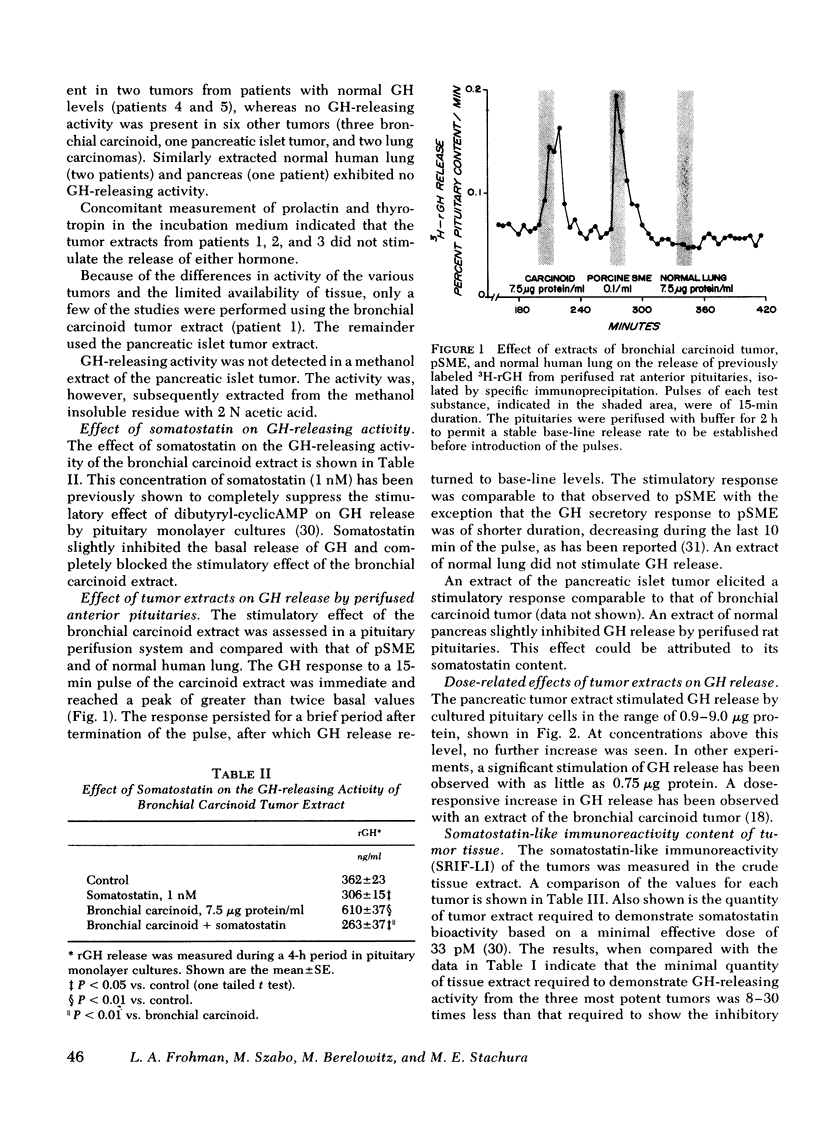
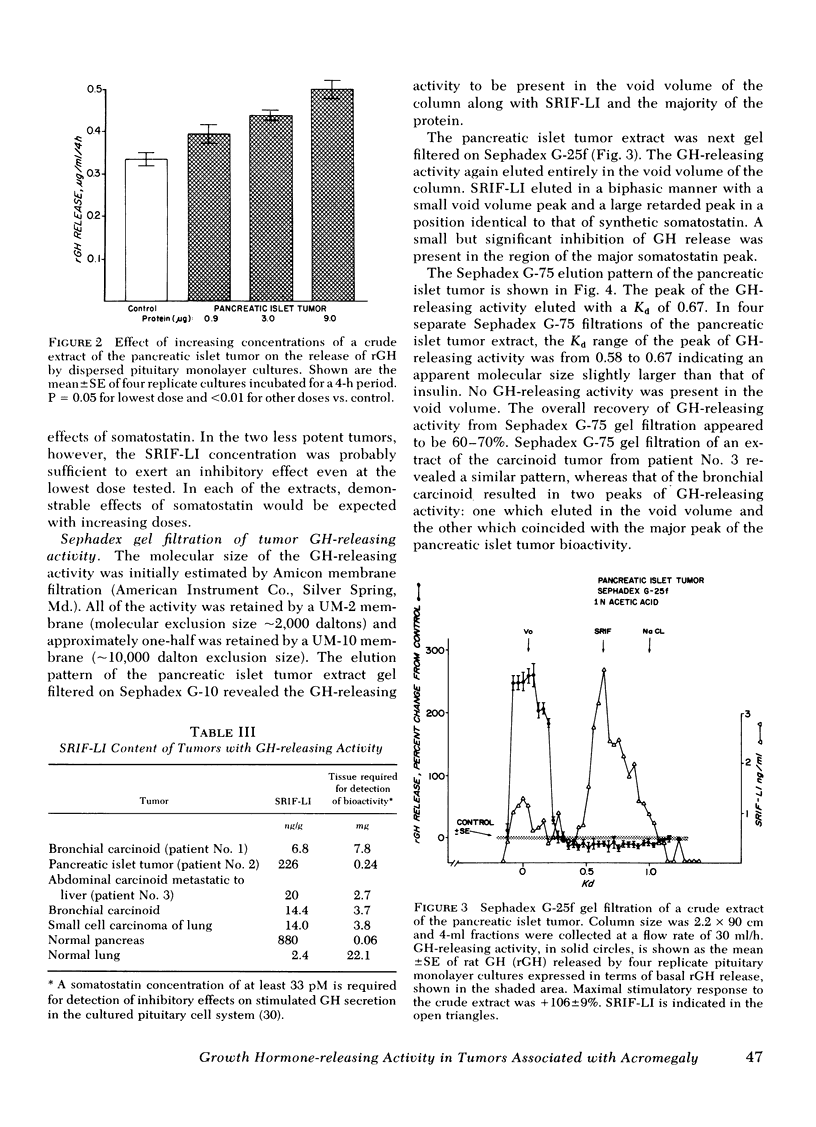

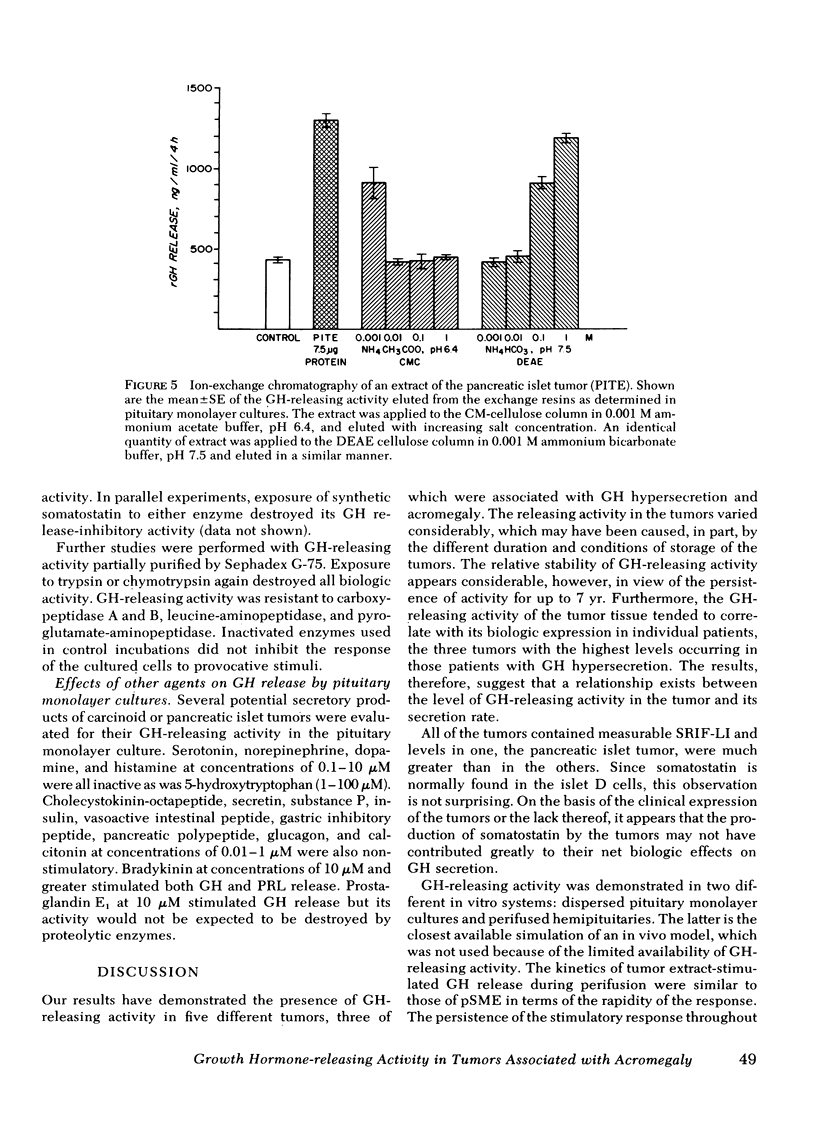
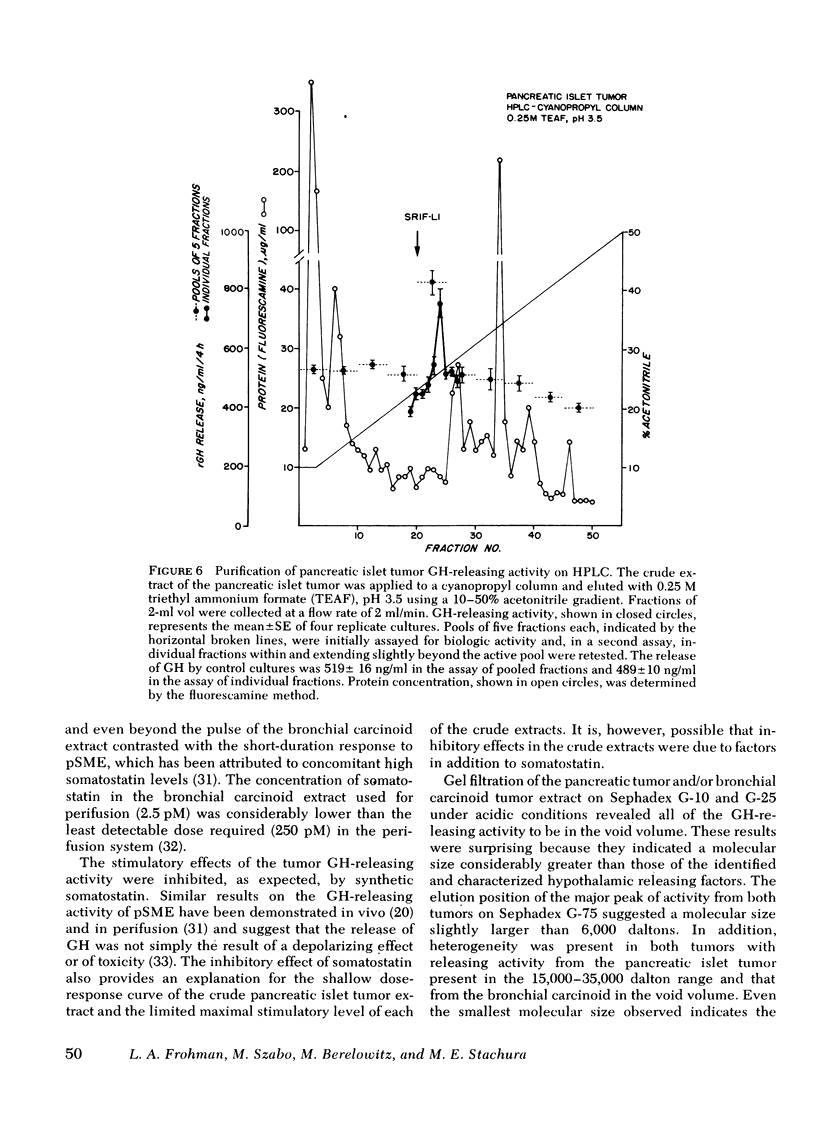

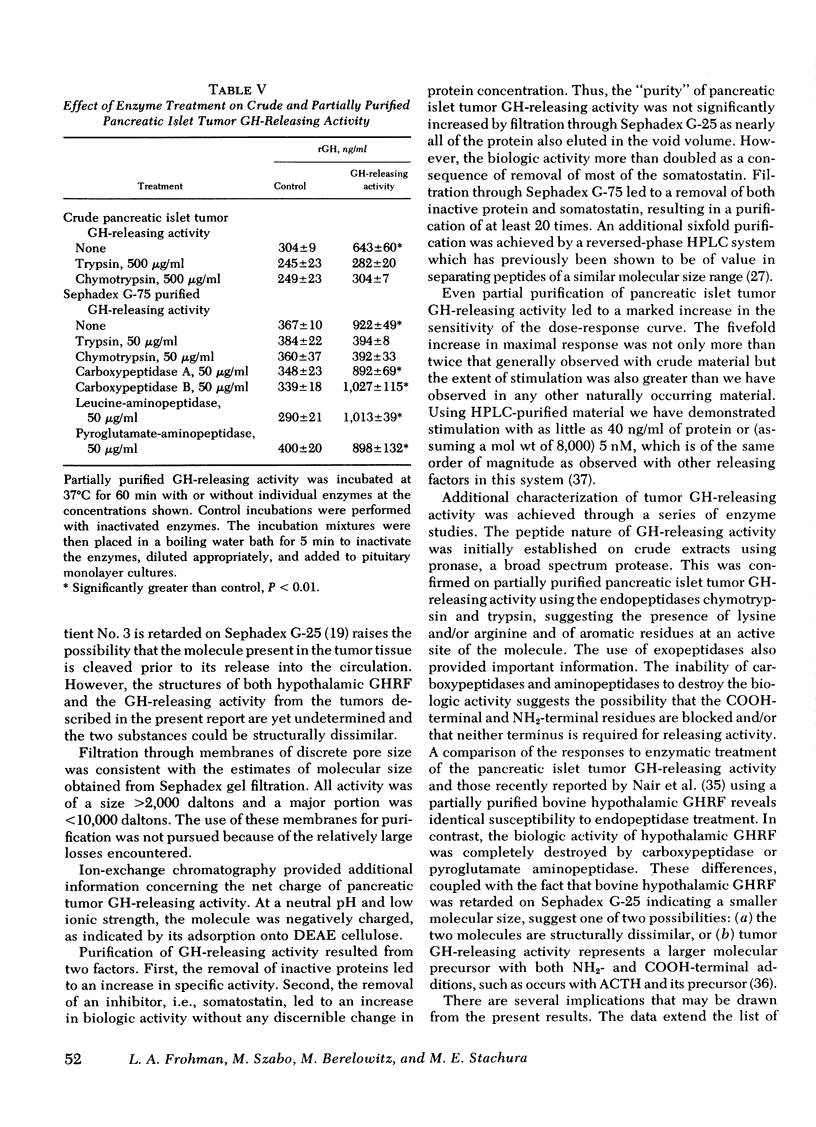
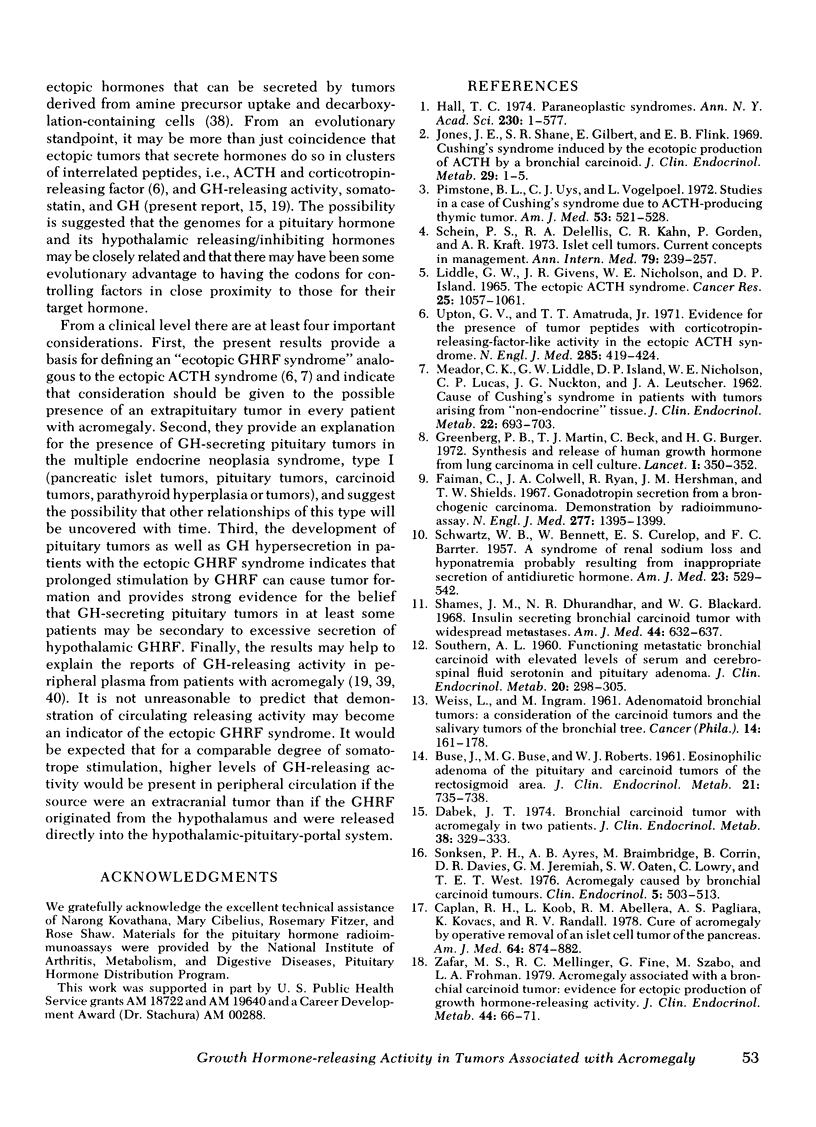
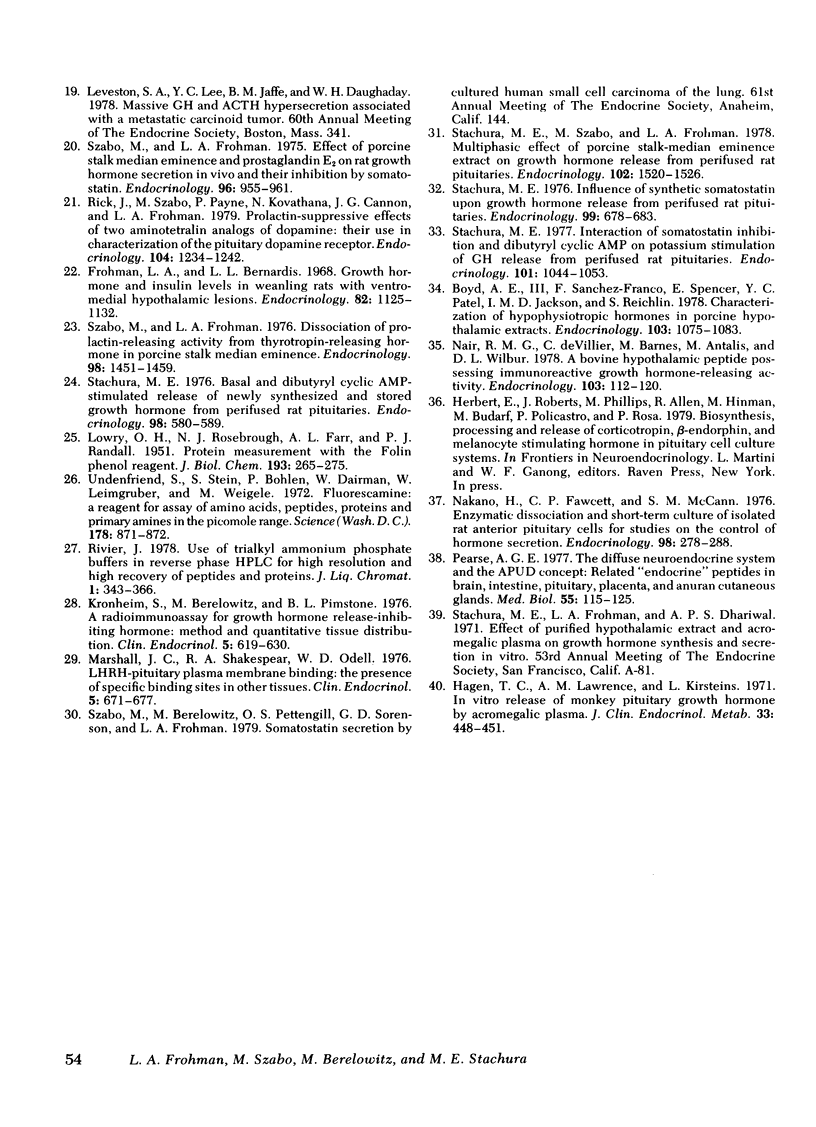
Selected References
These references are in PubMed. This may not be the complete list of references from this article.
- BUSE J., BUSE M. G., ROBERTS W. J., Jr Eosinophilic adenoma of the pituitary and carcinoid tumor of the rectosigmoid area. J Clin Endocrinol Metab. 1961 Jun;21:735–738. doi: 10.1210/jcem-21-6-735. [DOI] [PubMed] [Google Scholar]
- Boyd A. E., 3rd, Sanchez-Franco F., Spencer E., Patel Y. C., Jackson I. M., Reichlin S. Characterization of hypophysiotropic hormones in porcine hypothalamic extracts. Endocrinology. 1978 Oct;103(4):1075–1083. doi: 10.1210/endo-103-4-1075. [DOI] [PubMed] [Google Scholar]
- Caplan R. H., Koob L., Abellera R. M., Pagliara A. S., Kovacs K., Randall R. V. Cure of acromegaly by operative removal of an islet cell tumor of the pancreas. Am J Med. 1978 May;64(5):874–882. doi: 10.1016/0002-9343(78)90531-4. [DOI] [PubMed] [Google Scholar]
- Dabek F. T. Bronchial carcinoid tumour with acromegaly in two patients. J Clin Endocrinol Metab. 1974 Feb;38(2):329–333. doi: 10.1210/jcem-38-2-329. [DOI] [PubMed] [Google Scholar]
- Faiman C., Colwell J. A., Ryan R. J., Hershman J. M., Shields T. W. Gonadotropin secretion from a bronchogenic carcinoma. Demonstration by radioimmunoassay. N Engl J Med. 1967 Dec 28;277(26):1395–1399. doi: 10.1056/NEJM196712282772604. [DOI] [PubMed] [Google Scholar]
- Frohman L. A., Bernardis L. L. Growth hormone and insulin levels in weanling rats with ventromedial hypothalamic lesions. Endocrinology. 1968 Jun;82(6):1125–1132. doi: 10.1210/endo-82-6-1125. [DOI] [PubMed] [Google Scholar]
- Greenberg P. B., Martin T. J., Beck C., Burger H. G. Synthesis and release of human growth hormone from lung carcinoma in cell culture. Lancet. 1972 Feb 12;1(7746):350–352. doi: 10.1016/s0140-6736(72)92843-7. [DOI] [PubMed] [Google Scholar]
- Hagen T. C., Lawrence A. M., Kirsteins L. In vitro release of monkey pituitary growth hormone by acromegalic plasma. J Clin Endocrinol Metab. 1971 Sep;33(3):448–451. doi: 10.1210/jcem-33-3-448. [DOI] [PubMed] [Google Scholar]
- Jones J. E., Shane S. R., Gilbert E., Flink E. B. Cushing's syndrome induced by the ectopic production of ACTH by a bronchial carcinoid. J Clin Endocrinol Metab. 1969 Jan;29(1):1–5. doi: 10.1210/jcem-29-1-1. [DOI] [PubMed] [Google Scholar]
- Kronheim S., Berelowitz M., Pimstone B. L. A radioimmunoassay for growth hormone release-inhibiting hormone: method and quantitative tissue distribution. Clin Endocrinol (Oxf) 1976 Nov;5(6):619–630. doi: 10.1111/j.1365-2265.1976.tb03865.x. [DOI] [PubMed] [Google Scholar]
- LOWRY O. H., ROSEBROUGH N. J., FARR A. L., RANDALL R. J. Protein measurement with the Folin phenol reagent. J Biol Chem. 1951 Nov;193(1):265–275. [PubMed] [Google Scholar]
- Liddle G. W., Givens J. R., Nicholson W. E., Island D. P. The ectopic ACTH syndrome. Cancer Res. 1965 Aug;25(7):1057–1061. [PubMed] [Google Scholar]
- MEADOR C. K., LIDDLE G. W., ISLAND D. P., NICHOLSON W. E., LUCAS C. P., NUCKTON J. G., LUETSCHER J. A. Cause of Cushing's syndrome in patients with tumors arising from "nonendocrine" tissue. J Clin Endocrinol Metab. 1962 Jul;22:693–703. doi: 10.1210/jcem-22-7-693. [DOI] [PubMed] [Google Scholar]
- Marshall J. C., Shakespear R. A., Odell W. D. LHRH-pituitary plasma membrane binding: the presence of specific binding sites in other tissues. Clin Endocrinol (Oxf) 1976 Nov;5(6):671–677. doi: 10.1111/j.1365-2265.1976.tb03870.x. [DOI] [PubMed] [Google Scholar]
- Nair R. M., deVillier C., Barnes M., Antalis J., Wilbur D. L. A bovine hypothalamic peptide possessing immunoreactive growth hormone-releasing activity. Endocrinology. 1978 Jul;103(1):112–120. doi: 10.1210/endo-103-1-112. [DOI] [PubMed] [Google Scholar]
- Nakano H., Fawcett C. P., McCann S. M. Enzymatic dissociation and short-term culture of isolated rat anterior pituitary cells for studies on the control of hormone secretion. Endocrinology. 1976 Feb;98(2):278–288. doi: 10.1210/endo-98-2-278. [DOI] [PubMed] [Google Scholar]
- Pearse A. G. The diffuse neuroendocrine system and the apud concept: related "endocrine" peptides in brain, intestine, pituitary, placenta, and anuran cutaneous glands. Med Biol. 1977 Jun;55(3):115–125. [PubMed] [Google Scholar]
- Pimstone B. L., Uys C. J., Vogelpoel L. Studies in a case of Cushing's syndrome due to an ACTH-producing thymic tumour. Am J Med. 1972 Oct;53(4):521–528. doi: 10.1016/0002-9343(72)90149-0. [DOI] [PubMed] [Google Scholar]
- Rick J., Szabo M., Payne P., Kovathana N., Cannon J. G., Frohman L. A. Prolactin-suppressive effects of two aminotetralin analogs of dopamine: their use in the characterization of the pituitary dopamine receptor. Endocrinology. 1979 May;104(5):1234–1242. doi: 10.1210/endo-104-5-1234. [DOI] [PubMed] [Google Scholar]
- SCHWARTZ W. B., BENNETT W., CURELOP S., BARTTER F. C. A syndrome of renal sodium loss and hyponatremia probably resulting from inappropriate secretion of antidiuretic hormone. Am J Med. 1957 Oct;23(4):529–542. doi: 10.1016/0002-9343(57)90224-3. [DOI] [PubMed] [Google Scholar]
- SOUTHERN A. L. Functioning metastatic bronchial carcinoid with elevated levels of serum and cerebrospinal fluid serotonin and pituitary adenoma. J Clin Endocrinol Metab. 1960 Feb;20:298–305. doi: 10.1210/jcem-20-2-298. [DOI] [PubMed] [Google Scholar]
- Saeed uz Zafar M., Mellinger R. C., Fine G., Szabo M., Frohman L. A. Acromegaly associated with a bronchial carcinoid tumor: evidence for ectopic production of growth hormone-releasing activity. J Clin Endocrinol Metab. 1979 Jan;48(1):66–71. doi: 10.1210/jcem-48-1-66. [DOI] [PubMed] [Google Scholar]
- Schein P. S. Islet cell tumors: current concepts and management. Ann Intern Med. 1973 Aug;79(2):239–257. doi: 10.7326/0003-4819-79-2-239. [DOI] [PubMed] [Google Scholar]
- Shames J. M., Dhurandhar N. R., Blackard W. G. Insulin-secreting bronchial carcinoid tumor with widespread metastases. Am J Med. 1968 Apr;44(4):632–637. doi: 10.1016/0002-9343(68)90065-x. [DOI] [PubMed] [Google Scholar]
- Stachura M. E. Basal and dibutyryl cyclic AMP-stimulated release of newly synthesized and stored growth hormone from perifused rat pituitaries. Endocrinology. 1976 Mar;98(3):580–589. doi: 10.1210/endo-98-3-580. [DOI] [PubMed] [Google Scholar]
- Stachura M. E. Influence of synthetic somatostatin upon growth hormone release from perifused rat pituitaries. Endocrinology. 1976 Sep;99(3):678–683. doi: 10.1210/endo-99-3-678. [DOI] [PubMed] [Google Scholar]
- Stachura M. E. Interaction of somatostatin inhibition and dibutyryl cyclic AMP or potassium stimulation of growth hormone release from perifused rat pituitaries. Endocrinology. 1977 Oct;101(4):1044–1053. doi: 10.1210/endo-101-4-1044. [DOI] [PubMed] [Google Scholar]
- Stachura M. E., Szabo M., Frohman L. A. Multiphasic effect of porcine stalk-median eminence extract on growth hormone release from perifused rat pituitaries. Endocrinology. 1978 May;102(5):1520–1526. doi: 10.1210/endo-102-5-1520. [DOI] [PubMed] [Google Scholar]
- Szabo M., Frohman L. A. Dissociation of prolactin-releasing activity from thyrotropin-releasing hormone in porcine stalk median eminence. Endocrinology. 1976 Jun;98(6):1451–1459. doi: 10.1210/endo-98-6-1451. [DOI] [PubMed] [Google Scholar]
- Szabo M., Frohman L. A. Effects of porcine stalk median eminence and prostaglandin E2 on rat growth hormone secretion in vivo and their inhibition by somatostatin. Endocrinology. 1975 Apr;96(4):955–961. doi: 10.1210/endo-96-4-955. [DOI] [PubMed] [Google Scholar]
- Sönksen P. H., Ayres A. B., Braimbridge M., Corrin B., Davies D. R., Jeremiah G. M., Oaten S. W., Lowy C., West T. E. Acromegaly caused by pulmonary carcinoid tumours. Clin Endocrinol (Oxf) 1976 Sep;5(5):503–513. doi: 10.1111/j.1365-2265.1976.tb01979.x. [DOI] [PubMed] [Google Scholar]
- Udenfriend S., Stein S., Böhlen P., Dairman W., Leimgruber W., Weigele M. Fluorescamine: a reagent for assay of amino acids, peptides, proteins, and primary amines in the picomole range. Science. 1972 Nov 24;178(4063):871–872. doi: 10.1126/science.178.4063.871. [DOI] [PubMed] [Google Scholar]
- Upton G. V., Amatruda T. T., Jr Evidence for the presence of tumor peptides with corticotropin-releasing-factor-like activity in the ectopic ACTH syndrome. N Engl J Med. 1971 Aug 19;285(8):419–424. doi: 10.1056/NEJM197108192850801. [DOI] [PubMed] [Google Scholar]
- WEISS L., INGRAM M. Adenomatoid bronchial tumors. A consideration of the carcinoid tumors and the salivary tumors of the bronchial tree. Cancer. 1961 Jan-Feb;14:161–178. doi: 10.1002/1097-0142(196101/02)14:1<161::aid-cncr2820140120>3.0.co;2-n. [DOI] [PubMed] [Google Scholar]


